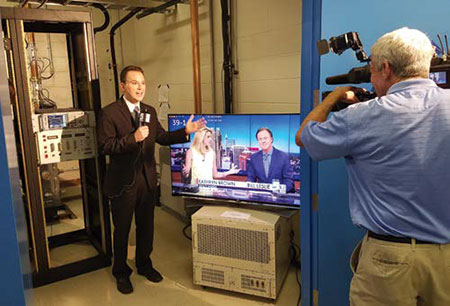20 Years Later, WRAL Is Still a Broadcast Pioneer
The year 1996 was a landmark one for broadcasters in the United States. In that year, the federal government revamped the rules governing the industry with the Telecommunications Act of 1996. It was also the year that the HDTV era was launched in the United States when WRAL-TV in Raleigh, N.C. commenced HDTV broadcasts in July; and it concluded with the FCC’s approval of the ATSC DTV standard at the end of the year. On their own, these were momentous events; in the aggregate, they represented a series of milestones that have influenced the industry ever since.

WRAL Reporter Brian Schrader introduces ATSC 3.0 to Raleigh viewers. That path to digital television was a rocky one, however. The rollout suffered from a lack of content and skepticism on both sides of the aisle; consumers were lukewarm about the cost of HDTV sets (with little to no HD to watch) and broadcasters were skeptical about the costs of transitioning to new technology. There was market confusion over what constituted “DTV” and “HDTV” and the fact that the two were not interchangeable. What drove the move to DTV was a government-mandated transition to digital; with HD being the “icing on the cake.”
Despite such skepticism, some early pioneers took the plunge, most notably WRAL. In the summer of 1996, when the station began broadcasting in HD, there was no approved DTV standard yet, little to no HD content to watch and much of the technology to produce and transmit in digital had yet to be developed. “A TV station will have to completely rebuild,” the station’s chief engineer Tom Beauchamp told TV Technology at the time, adding that “there are a lot of unknowns.”
Perhaps it’s appropriate then that 20 years later—almost to the month—WRAL again made industry headlines with the launch of the nation’s first commercial ATSC 3.0 broadcasts. Operating on Channel 39 under an experimental license from the FCC, the official launch began on June 29, with a WRAL News at Noon newscast and a simultaneous second channel broadcasting a sports documentary shot, edited and posted in 4K/UHD HDR.
The Capitol Broadcasting Corporation-owned station said it planned to use ATSC 3.0 to showcase the capabilities of next-gen TV, including on-demand content, access to multiple sources of video to enhance linear viewing and a number of other 24/7 streams of TV and radio programming in a representation of what it terms “the marriage of broadcasting and broadband.”
WRAL is relying on a number of forward thinking technology vendors including ERI, GatesAir, Harmonic, LG and Triveni Digital to develop and test new ATSC gear. “We will be broadcasting throughout Raleigh and Durham, N.C. and performing test measurements to learn about the characteristics of this new delivery platform,” said CBC Director of Engineering and Operations Pete Socket. “We will share this information with fellow broadcasters and equipment manufacturers to test their new designs in the real world.”
The NAB, along with several broadcast groups are urging the FCC to approve use of the ATSC 3.0 standard by Oct. 1. Coupled with WRAL’s test launch, we’re seeing a rapid move towards real implementation. Where it goes after that will depend on a number of factors, both within and out of our control, but with pioneering broadcasters like WRAL—who continue to demonstrate their technology leadership throughout the past two decades—the chances for success are that much greater.
Get the TV Tech Newsletter
The professional video industry's #1 source for news, trends and product and tech information. Sign up below.
Tom has covered the broadcast technology market for the past 25 years, including three years handling member communications for the National Association of Broadcasters followed by a year as editor of Video Technology News and DTV Business executive newsletters for Phillips Publishing. In 1999 he launched digitalbroadcasting.com for internet B2B portal Verticalnet. He is also a charter member of the CTA's Academy of Digital TV Pioneers. Since 2001, he has been editor-in-chief of TV Tech (www.tvtech.com), the leading source of news and information on broadcast and related media technology and is a frequent contributor and moderator to the brand’s Tech Leadership events.

